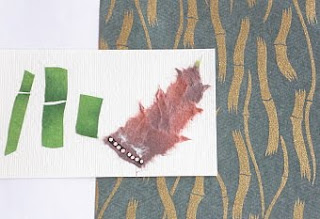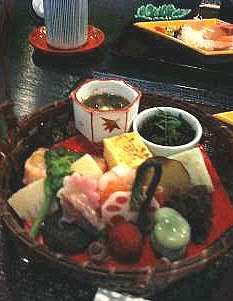●Hidakagawa Iriaizakura(日高川入相花王)
The highlight of this bunraku play is transformation in an eye's blink from beautiful Kiyohime to a demon with horns, the mouth stretched from ear to ear and gold round eyes.
A puppeteer operates the mechanical head called "gabu(ガブ)". In an eye's blink, the transformed demon is back to Kiyohime's usual self by operating the head with fingers.
The play was premiered as a bunraku play in 1759 and written by Takeda Koizumo(竹田小出雲),Chikamatsu Hanji(近松半二),Kitamado Goichi(北窓後一),Takemomoto Saburubei(竹本三郎兵衛) and Nifudou(二歩堂).
This story is based on the famous legend of "Anchin Kiyohime(安珍 清姫)" set in Dojoji(道成寺), which is located in the town of Hidakagawa, Wakayama Prefecture.
Legend has it that priest Anchin(安珍) escaped from his lover Kiyohime(清姫) into Dojoji across the Hidaka river and hid inside the bell of the temple. A boatman refused to take her on board at his request, so she junped into the river. While swimming across the river, she turned into a huge serpent in a towering rage. However, the serpent found out that he was inside the bell. It twisted itself around the bell and burned him to death.
Various traditional Japanese performing arts in the motif of a sequel to the legend were made as the noh play titled "Dojoji(道成寺)", as the kabuki dance and Japanese dance titled "Musume-Dojoji(娘道成寺)".
Now women practice Japanese dancing as a pastime.

These are Makimono-gashi(蒔物菓子) on the subject of Dojoji, cherry blossoms and the bell of the temple. It is a confection that is handed to invited guests to Japanese dance or koto recital as a souvenir. It's made to the design associated with the recital's program.
Iriaizakura(入相桜), which is a kind of cherry cultivars named Edohigan, and another kinds of cherry trees are planted on the temple grounds of Dojoji. Today Iriaizakura has begun to fall, but yoshino cherry trees are in full bloom.
●Yoshitsune Senbon Zakura (義経千本桜:Yoshitsune and the Thousand Cherry Trees)
The scene, "Michiyuki Hatsune no Tabi(道行初音旅)", began with music and chants by an array of narrators(named tayu) and shamisen players. On the stage, a pale blue vast cloth was suspended from above the stage as a stage curtain.
In the middle of chanting, the cloth had fallen in on the stage.
Just then, my eyes were glued to the vivid scenery of cherry-blossomed Yoshino on the stage.
It was the great dramatic production that I've never seen.
The play was premiered as a bunraku play in 1747, as a kabuki play in 1748. The main character is Minamoto no Yoshitsune who is pursued by his brother. In the scene, his retainer Sato Tadanobu accompanied his mistress Shizuka to Yoshino where Yoshitsune hid himself.
Despite they are taking refuge in Yoshino, the scene looks brilliant.
●Sakurano mori no mankai no shita(桜の森の満開の下:In the Forest, Under Cherries in Full Bloom)written by Ango Sakaguchi (坂口 安吾, 1906 - 1955)
Having parties under the cherry blossoms is common sight in the spring. However, by taking humans off the sight, it becomes horrifying one.
●Sakura no ki no shita niwa(桜の樹の下には:Under the Cherry Trees)written by Motojiro Kajii (梶井 基次郎, 1901-1932)
" Dead bodies are buried under the cherry trees! …
How else would cherry blossoms have come out in a wonderful degree."

"cherry blossoms" designed by Kazuko Togami
さくらB デザイン:戸上和子
Kazuko Togami, Washi-de-Tsukuru-Etegami 220(Tokyo:Boutique-sha.co.,1999), p.12
戸上和子著,「和紙で作る絵てがみ」(東京:株式会社ブティック社,1999年),P.12







